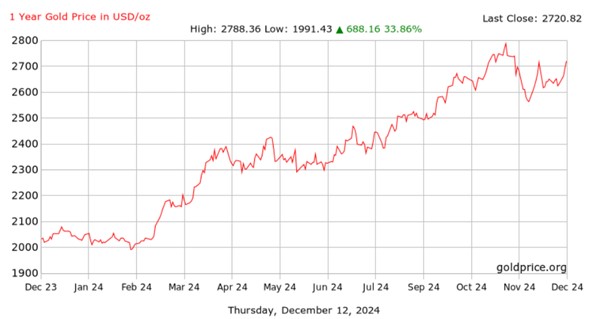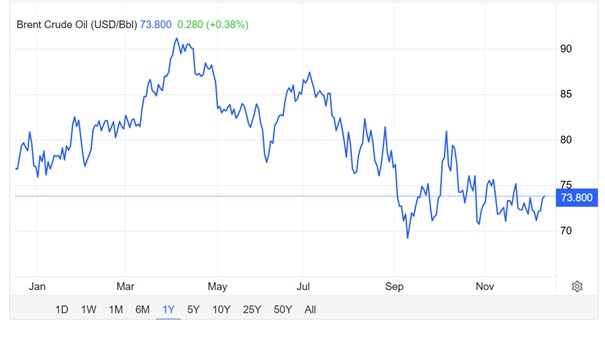
As we step into 2025, being flexible and using strategies that have stood the test of time is more important than ever. From riding trends to capitalizing on market swings or even embracing volatility, there’s a strategy for every trader, whether you’re just starting out or have been in the game for years.
In this article, we will explore 5 effective strategies you can apply in 2025 to become a successful trader:
Trends are among the most reliable indicators in financial markets, providing insights into the direction of price movements over a specific period. In 2025, following trends seems more important than ever, given the market setup and events that unfolded in 2024.
Last year, developments like central banks adjusting interest rates to combat inflation and geopolitical tensions led to strong, sustained trends across major asset classes. For instance, the U.S. dollar experienced a significant uptrend in late 2024 due to hawkish Federal Reserve policies. They offer clear signals for traders using trend-following strategies.
Building on these observations, trend-following strategies in 2025 emphasize aligning with the market's current direction. They operate on the assumption that established price movements are likely to persist.
Here are the key tools you can use to identify and follow trends:
Swing trading is all about capturing the market's short- to medium-term moves. Think of it as surfing the market’s waves, aiming to ride the highs and avoid the wipeouts. Positions are typically held for a few days to a few weeks, with traders focusing on temporary price swings rather than worrying about the overall market direction.
For example, imagine a trader analyzing Tesla's stock (TSLA), which is currently priced at $424.77. Over the past few weeks, the stock has been fluctuating between $410 (support) and $440 (resistance). By applying swing trading, the trader could buy near $410 and sell near $440, profiting from these predictable movements while setting a stop-loss at $405 to manage risk.
This strategy relies on technical analysis tools like trendlines, RSI, and moving averages to predict how prices will react at key levels. Swing trading is rooted in analyzing price charts. Support and resistance levels, Fibonacci retracement, moving averages, and RSI are tools that can help identify entry and exit points for your trades.
Volatility can be a trader’s best friend—or worst enemy—depending on how well it’s managed. High volatility markets are where bold moves happen, but they also demand precision and discipline.
For example, consider gold (XAUUSD). In early 2023, heightened geopolitical tensions and concerns over inflation caused gold prices to surge from $1,850 to over $2,000 in just a few weeks, with daily volatility spiking aggressively.

A trader using Bollinger Bands during this period might have identified breakout opportunities when gold prices moved outside the upper band, signaling strong momentum. Similarly, ATR (Average True Range) could have highlighted increased daily price movements, helping traders adjust their position sizes accordingly.
When applying trading strategies based on volatility, consider the following points:
With gold expected to remain volatile in 2025, traders who follow disciplined strategies can navigate the swings like professionals. This approach allows them to turn market chaos into profits while managing risks effectively.
Short-term momentum strategies aim to analyze the momentum of an asset's price to make buy or sell decisions. These strategies are based on the assumption that prices will maintain their current direction and are particularly effective in fast-moving markets. With increased volatility and market fluctuations expected in 2025, short-term momentum strategies may offer attractive opportunities for traders.
Consider the recent performance of Brent Crude Oil, which reflects changes in global crude oil prices. As of December 12, 2024, Spot Brent is trading at $73.33, up approximately 2.75% from the previous close. This increase can be linked to factors such as higher demand expectations driven by China's looser monetary policy and the potential impact of U.S. sanctions on Russian oil, which could further tighten global supply.

Such strategies typically rely on technical analysis indicators. Tools like RSI (Relative Strength Index), MACD (Moving Average Convergence Divergence), and the Stochastic Oscillator are commonly used to determine whether an asset is overbought or oversold and to analyze whether the trend is likely to continue. Specifically, RSI provides momentum insights, signaling overbought conditions above 70 and oversold conditions below 30.
The year 2025 may be an ideal time to apply momentum strategies in rapidly growing sectors such as technology stocks, renewable energy, and artificial intelligence. Stocks in these sectors could exhibit sharp price movements driven by positive news flow and macroeconomic developments.
Fundamental analysis is based on examining economic, financial, and sectoral factors to determine the intrinsic value of an asset. This approach allows you to ground your investment decisions on solid foundations and make strategic moves aligned with your long-term goals.
Key factors to consider in fundamental analysis include a company's financial health, sector performance, and overall economic conditions. The main areas of focus are as follows:
In 2025, developing fundamental analysis-driven strategies can help you capitalize on opportunities in innovative sectors and build a more stable portfolio during periods of volatility. Regularly monitoring company reports, sectoral analyses, and economic indicators will support your journey toward achieving your long-term investment goals.
Which sectors are suitable for volatility-based strategies in 2025?
Energy, technology, renewable energy, and healthcare are prime candidates. For example, energy prices may fluctuate due to geopolitical events, while technology and renewable energy sectors could see price swings driven by innovation or regulation.
How can the Volatility Index (VIX) guide trading strategies?
The VIX or "fear index," reflects market volatility. High VIX levels often present short-term trading opportunities, while low levels favor long-term investments. Monitoring the VIX helps traders adjust their strategies based on current market conditions.
What tools can be used to identify trend reversals?
Key tools include RSI and MACD for signaling reversals, chart patterns like head and shoulders, and Fibonacci retracement for pinpointing potential correction levels. These tools help traders anticipate changes in trend direction.
Which assets are suitable for short-term momentum strategies in 2025?
High-volatility assets like Tesla, Nvidia, and cryptocurrencies such as Bitcoin and Ethereum are ideal. These assets often exhibit sharp price movements, making them perfect for capturing short-term momentum.
How can short-term and long-term strategies be combined?
Allocate part of your portfolio to long-term investments, like stable sector stocks, and use the rest for short-term trades to capitalize on market swings. This approach balances risk and return while aligning with your financial goals.
 Introduction to cTrader: The Quick Setup Every Trader Should Know
Introduction to cTrader: The Quick Setup Every Trader Should Know
Let's turn the default cTrader view into a workspace that matches how you trade with practical watchlists, default chart templates, and order ticket settings.
Detail Choosing a Broker for Gold Trading
Choosing a Broker for Gold Trading
What to Consider When Choosing a Broker for Gold? In this guide, we will look at the decision-making process from a trader’s eyes.
Detail Historical Movements of Gold: What to expect in 2026?
Historical Movements of Gold: What to expect in 2026?
Will gold continue rising in 2026? Explore key drivers, past trends, and three realistic scenarios shaping next year’s gold outlook.
DetailThen Join Our Telegram Channel and Subscribe Our Trading Signals Newsletter for Free!
Join Us On Telegram!